Geography Playlist
19 chapters • 0 completed
The Universe and the Earth
18 topics
Atmosphere and its composition
6 topics
Atmospheric Temperature
11 topics
Atmospheric Moisture
9 topics
Air Mass, Fronts & Cyclones
15 topics
Evolution of Earths Crust, Earthquakes and Volcanoes
23 topics
Interior of The Earth
14 topics
Landforms
25 topics
Geomorphic Processes
10 topics
Movement of Ocean Water
16 topics
Oceans and its Properties
12 topics
Climate of a Region
14 topics
Indian Geography - introduction, Geology
5 topics
Physiography of India
27 topics
Indian Climate
20 topics
Indian Drainage
32 topics
Soil and Natural Vegetation
13 topics
Mineral and Energy Resources, Industries in India
28 topics
Indian Agriculture
22 topics
Chapter 12: Climate of a Region
Chapter TestFactors Affecting Climate of a Region
Climate of a region depends on latitude, altitude, proximity to sea, prevailing winds, cloud cover, ocean currents, mountain ranges, soil and vegetation, and slope. These factors together regulate temperature, rainfall, and seasonal variations.
Climate of a region depends on latitude, altitude, proximity to sea, prevailing winds, cloud cover, ocean currents, mountain ranges, soil and vegetation, and slope. These factors together regulate temperature, rainfall, and seasonal variations.
Major Climatic Controls
| Factor | Effect on Climate | Example |
|---|---|---|
| Latitude | Direct/oblique sun rays control temperature | Equator vs. Poles |
| Altitude | Temperature decreases with height | Himalayan hill stations |
| Distance from Sea | Equable vs. continental climate | Mumbai vs. Delhi |
| Ocean Currents | Warm ↑ rainfall, Cold ↓ rainfall | Gulf Stream & Peru Current |
| Mountain Ranges | Orographic rainfall & rain shadow | Western Ghats (rainy) vs. Deccan Plateau (dry) |
Mains Key Points
Prelims Strategy Tips
Climate Classification
Climate classification groups regions based on temperature, precipitation, and causative factors. Köppen’s classification is the most widely used empirical scheme, dividing the world into five major climate groups with subcategories.
Climate classification groups regions based on temperature, precipitation, and causative factors. Köppen’s classification is the most widely used empirical scheme, dividing the world into five major climate groups with subcategories.
Köppen’s Climatic Groups
| Group | Basis | Regions/Examples |
|---|---|---|
| A - Tropical | All months >18°C | Amazon Basin, Congo Basin, SE Asia |
| B - Dry | Low rainfall (arid/semi-arid) | Sahara Desert, Thar Desert |
| C - Mild Mid-latitude | Winters mild, coldest month 0–18°C | Mediterranean, SE USA |
| D - Cold Mid-latitude | Cold winters (<0°C) | Canada, Siberia |
| E - Polar | Cold summers & winters | Antarctica, Greenland |
Mains Key Points
Prelims Strategy Tips
Köppen’s Climatic Regions
Köppen classified global climates into groups (A-E, H) based on temperature and precipitation. Each group is further subdivided into subtypes with unique rainfall and temperature patterns.
Köppen classified global climates into groups (A-E, H) based on temperature and precipitation. Each group is further subdivided into subtypes with unique rainfall and temperature patterns.
Köppen Climate Groups & Subtypes
| Group | Type | Characteristics | Distribution | Climate |
|---|---|---|---|---|
| A - Tropical Humid | Af - Tropical Wet | Uniform rainfall, hot temperature | Equator (Amazon, Congo, Indonesia) | Daily convectional rainfall, uniformly hot |
| A - Tropical Humid | Am - Tropical Monsoon | Reversal of winds, summer rain, dry winter | India, NE South America, N. Australia | Summer rain, dry winter |
| A - Tropical Humid | Aw - Tropical Wet & Dry | Distinct wet/dry seasons, droughts common | Brazil, Sudan, Central Africa | Less rainfall, seasonal droughts |
| B - Dry | BWh/BSh - Desert & Steppe | Low rainfall, extreme temps, arid to semi-arid | Sahara, Thar, Arabia | Hot deserts, dry steppe zones |
| C - Warm Temperate | Cwa - Humid Subtropical (dry winter) | Summer rain, mild winters | North India, S. China | Warm summers, mild winters |
| C - Warm Temperate | Cs - Mediterranean | Hot dry summer, mild wet winter | Mediterranean Basin, California, Chile | Summer drought, winter rains |
| C - Warm Temperate | Cfa - Humid Subtropical | Humid, summer thunderstorms | SE USA, SE China, Japan | High summer humidity, rainfall 75–150 cm |
| C - Warm Temperate | Cfb - Marine West Coast | Moderate, oceanic influence | W. Europe, New Zealand, Chile | Cool summers, mild winters |
| D - Cold Snow Forest | Df - Humid Winters | Cold snowy winters, short summer | Poleward of Marine West Coast (Canada, Russia) | Cold winters, frost-free short summer |
| D - Cold Snow Forest | Dw - Dry Winters | Cold winters, summer rainfall | NE Asia (Siberia, Mongolia) | Extremely cold winters, summer rain |
| E - Polar | ET - Tundra | Cold summers <10°C, scanty rainfall | Arctic coast, Alaska, Canada, Himalayas | Cold, long daylight in summer |
| E - Polar | EF - Ice Cap | Perennial frost, below 0°C year-round | Greenland, Antarctica | Extremely cold, minimal precipitation |
| H - Highland | Highland Climates | Temperature/precipitation vary with elevation | Tibetan Plateau, Andes, Kilimanjaro | Varied microclimates by altitude |
Mains Key Points
Prelims Strategy Tips
Hot, Wet Equatorial Climate
Found near the equator (5º–10º N/S), this climate is marked by high uniform temperatures, heavy rainfall, dense evergreen forests, and primitive tribal livelihoods.
Found near the equator (5º–10º N/S), this climate is marked by high uniform temperatures, heavy rainfall, dense evergreen forests, and primitive tribal livelihoods.
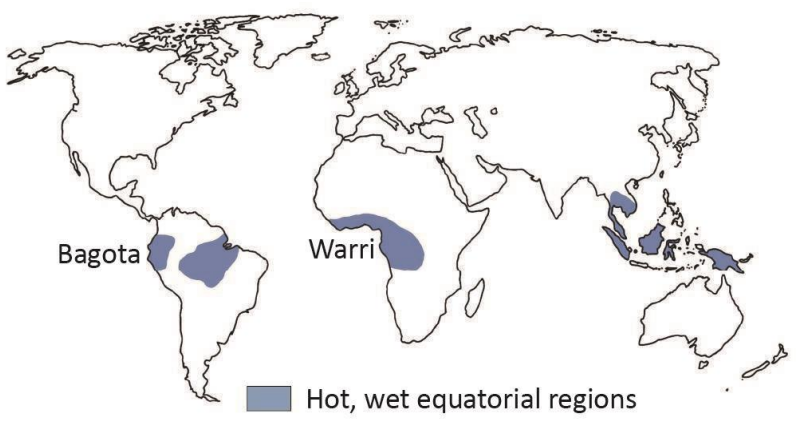
Key Features of Hot, Wet Equatorial Climate
| Aspect | Details |
|---|---|
| Temperature | Uniform ~27ºC, no winter |
| Rainfall | 150–250 cm annually, convectional type |
| Vegetation | Evergreen rainforests, hardwoods, mangroves |
| Tribes | Pygmies (Congo), Orang Asli (Malaysia) |
| Economic Activity | Shifting cultivation, forest products, gathering |
Mains Key Points
Prelims Strategy Tips
Tropical Monsoon and Tropical Marine Climates
These climates occur between 5º–30º latitude on either side of the equator. The monsoon climate is driven by seasonal reversal of winds, while the marine climate is influenced by trade winds. Both support deciduous vegetation and agriculture.
These climates occur between 5º–30º latitude on either side of the equator. The monsoon climate is driven by seasonal reversal of winds, while the marine climate is influenced by trade winds. Both support deciduous vegetation and agriculture.
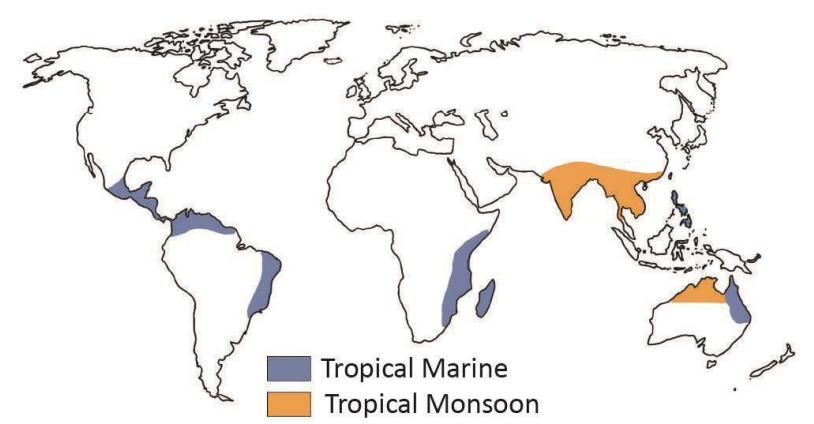
Comparison: Tropical Monsoon vs Tropical Marine Climate
| Aspect | Tropical Monsoon | Tropical Marine |
|---|---|---|
| Distribution | India, SE Asia, N. Australia | Caribbean, East Africa, NE Australia, Brazil |
| Rainfall | Seasonal, summer rains, dry winter | More uniform, trade-wind driven |
| Wind System | Reversal: SW monsoon (summer), NE monsoon (winter) | Steady trade winds |
| Vegetation | Deciduous forests (teak, sal) | Similar but more coastal vegetation |
| Economy | Agriculture (paddy, sugarcane) | Agriculture + fishing, trade |
Mains Key Points
Prelims Strategy Tips
Savannah or Sudan Climate
The Savannah climate is a transitional type between equatorial forests and hot deserts, marked by tall grasses, scattered trees, distinct wet and dry seasons, and rich wildlife known as 'Big Game Country'.
The Savannah climate is a transitional type between equatorial forests and hot deserts, marked by tall grasses, scattered trees, distinct wet and dry seasons, and rich wildlife known as 'Big Game Country'.
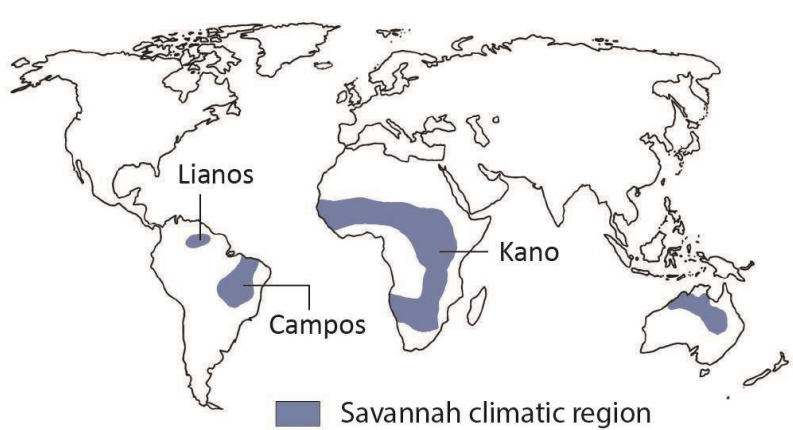
Savannah Climate – Key Features
| Aspect | Description |
|---|---|
| Temperature | 18°C+ annually; hot days and cool nights |
| Rainfall | 80–160 cm; seasonal (wet & dry) |
| Vegetation | Tall grasses, scattered deciduous trees |
| Wildlife | Big game animals, predators, reptiles in rivers |
| Economy | Pastoralism, shifting cultivation, tourism |
Mains Key Points
Prelims Strategy Tips
Hot Desert and Mid-Latitude Desert Climates
Desert climates are marked by extreme aridity, intense temperature ranges, and sparse xerophytic vegetation. Hot deserts lie between 15º–30º latitudes, while mid-latitude deserts occur in rain shadows and continental interiors.
Desert climates are marked by extreme aridity, intense temperature ranges, and sparse xerophytic vegetation. Hot deserts lie between 15º–30º latitudes, while mid-latitude deserts occur in rain shadows and continental interiors.
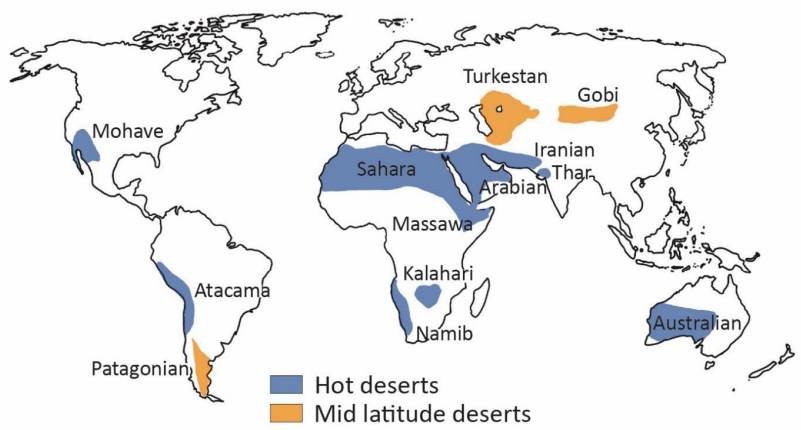
Hot vs Mid-Latitude Desert Climate
| Aspect | Hot Desert | Mid-Latitude Desert |
|---|---|---|
| Location | 15º–30º latitudes, western margins | Continental interiors, rain shadows |
| Rainfall | Very low (<25 cm annually) | Low, but slightly higher than hot deserts |
| Temperature | Very high, extreme diurnal range | Hot summers, very cold winters |
| Vegetation | Xerophytes, sparse trees | Sparse, cold-adapted xerophytes |
| Examples | Sahara, Atacama, Thar, Kalahari | Ladakh, Gobi, Taklamakan, Patagonian |
Mains Key Points
Prelims Strategy Tips
Warm Temperate Western Margin (Mediterranean) Climate
Mediterranean climate is characterized by hot, dry summers and mild, wet winters, supporting citrus cultivation and viticulture. It is found in regions bordering the Mediterranean Sea and on western margins of continents around 30º–40º latitudes.
Mediterranean climate is characterized by hot, dry summers and mild, wet winters, supporting citrus cultivation and viticulture. It is found in regions bordering the Mediterranean Sea and on western margins of continents around 30º–40º latitudes.
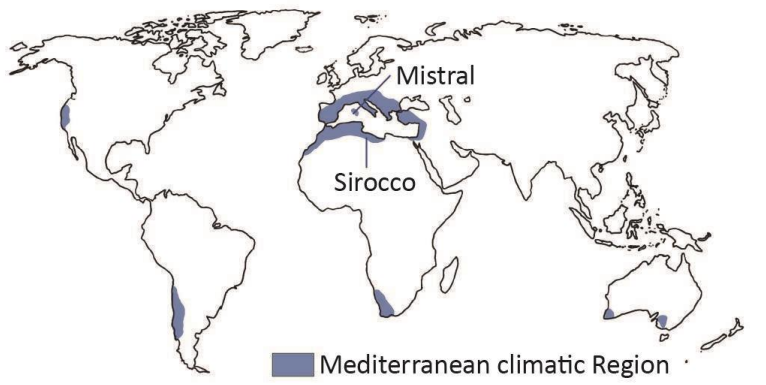
Key Features of Mediterranean Climate
| Aspect | Characteristic |
|---|---|
| Latitude | 30º–40º on western margins of continents |
| Summer | Hot, dry, trade-wind influence |
| Winter | Mild, wet, westerly influence |
| Rainfall | 35–90 cm annually, mostly in winter |
| Vegetation | Evergreen shrubs, citrus fruits, olives, grapes |
| Economy | Fruit cultivation, wine, olive oil, tourism |
Mains Key Points
Prelims Strategy Tips
Temperate Continental (Steppe) Climate
The Steppe climate is marked by hot summers, cold winters, and low rainfall, supporting temperate grasslands that serve as the world’s wheat and maize granaries.
The Steppe climate is marked by hot summers, cold winters, and low rainfall, supporting temperate grasslands that serve as the world’s wheat and maize granaries.
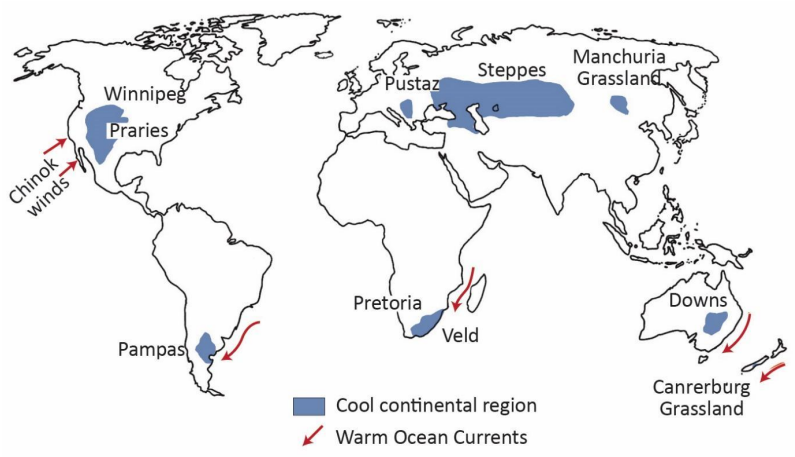
Regional Names of Temperate Grasslands
| Region | Local Name |
|---|---|
| Hungary | Puszta |
| North America | Prairies |
| Argentina & Uruguay | Pampas |
| North-South Africa | Bush-Veld |
| South-South Africa | High Veldts |
| Southern Australia | Downs |
| New Zealand | Canterbury Plains |
Mains Key Points
Prelims Strategy Tips
Warm Temperate Eastern Margin Climate
This climate occurs along the east coasts between 20°–35° latitudes in both hemispheres. It is marked by hot, humid summers, cool to cold winters, year-round rainfall (varies by subtype), and supports intensive agriculture and diverse forests.
This climate occurs along the east coasts between 20°–35° latitudes in both hemispheres. It is marked by hot, humid summers, cool to cold winters, year-round rainfall (varies by subtype), and supports intensive agriculture and diverse forests.
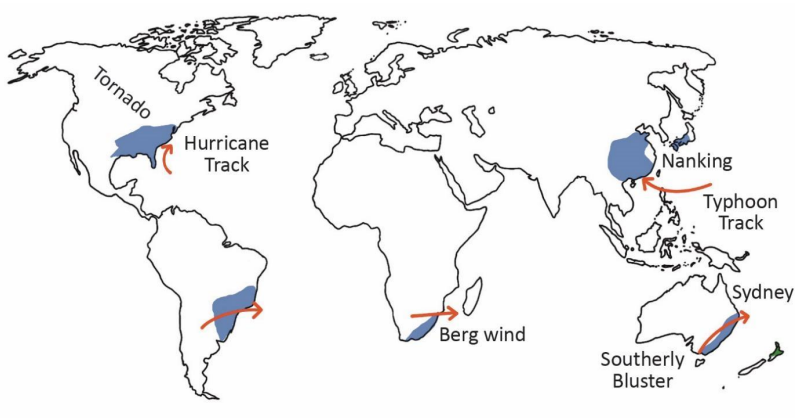
Subtypes of Warm Temperate Eastern Margin Climate
| Subtype | Region | Key Features |
|---|---|---|
| China Type | China, Southern Japan | Temperate monsoons, wet summers, dry winters |
| Gulf Type | Southeastern USA | Atlantic influence, humid summers, rainfall year-round |
| Natal Type | South Africa, SE Brazil, NSW Australia | Year-round rainfall, humid winters |
Mains Key Points
Prelims Strategy Tips
Cool Temperate Western Margin (British Type) Climate
This climate, also known as the 'British Type', is dominated by year-round westerlies and cyclonic activity, with mild summers, cool winters, and uniform rainfall. It supports deciduous hardwood forests and highly industrialized economies.
This climate, also known as the 'British Type', is dominated by year-round westerlies and cyclonic activity, with mild summers, cool winters, and uniform rainfall. It supports deciduous hardwood forests and highly industrialized economies.
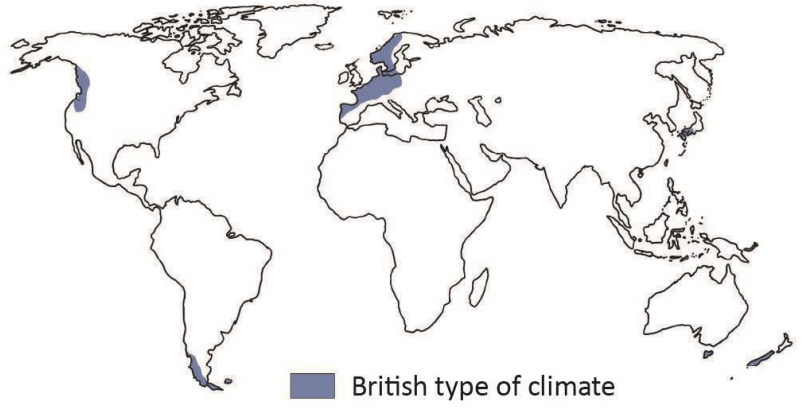
Key Features of Cool Temperate Western Margin Climate
| Aspect | Characteristic |
|---|---|
| Temperature | 5°C–15°C, mild summers, cool winters |
| Rainfall | Uniform year-round, peaks in autumn/winter |
| Vegetation | Deciduous forests (oak, elm, beech, birch) |
| Economy | Industrial hub, fishing, mixed farming |
Mains Key Points
Prelims Strategy Tips
Cool Temperate Continental (Siberian) Climate
This climate is confined to the Northern Hemisphere, with severe winters, short summers, and coniferous taiga vegetation. It is a global hub of softwood forestry but supports very limited agriculture due to extreme cold.
This climate is confined to the Northern Hemisphere, with severe winters, short summers, and coniferous taiga vegetation. It is a global hub of softwood forestry but supports very limited agriculture due to extreme cold.
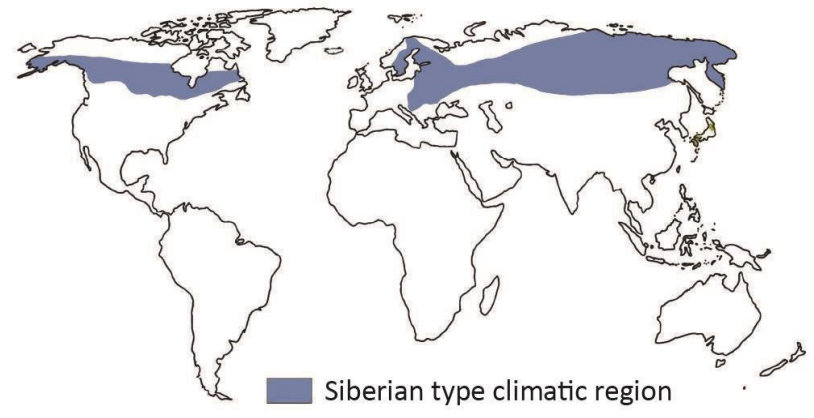
Key Features of Cool Temperate Continental (Siberian) Climate
| Aspect | Characteristic |
|---|---|
| Temperature | Severe winters, short cool summers, very high annual range |
| Precipitation | 15–25 inches annually, mostly as snow |
| Vegetation | Coniferous forests (pine, spruce, fir, larch) |
| Economy | Forestry, newsprint, hunting, fishing, limited agriculture |
Mains Key Points
Prelims Strategy Tips
Cool Temperate Eastern Margin (Laurentian) Climate
This climate features cold, snowy winters and hot, humid summers with summer-rainfall dominance. Found in northeast North America and east Asia, it supports forestry, pulp and paper industries, hardy agriculture, and rich fishing activities.
This climate features cold, snowy winters and hot, humid summers with summer-rainfall dominance. Found in northeast North America and east Asia, it supports forestry, pulp and paper industries, hardy agriculture, and rich fishing activities.
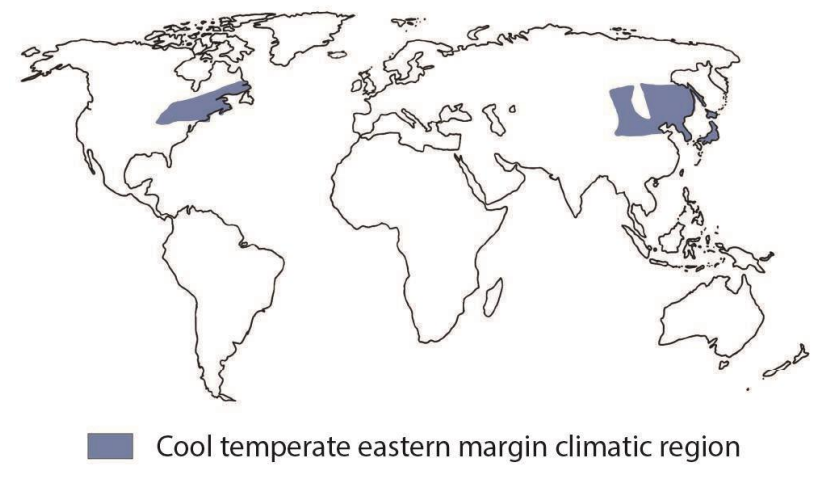
Key Features of Laurentian Climate
| Aspect | Characteristic |
|---|---|
| Temperature | Cold snowy winters, hot humid summers (21–27°C) |
| Precipitation | 30–60 inches annually, two-thirds in summer |
| Vegetation | Cold temperate forests (oak, beech, maple, birch) |
| Economy | Forestry, paper industry, hardy agriculture, rich fishing |
Mains Key Points
Prelims Strategy Tips
Arctic or Polar Climate
Polar climate is marked by extremely low temperatures, long harsh winters, and short cool summers. Found mainly in Greenland, northern Canada, Alaska, and Arctic Eurasia, it supports tundra vegetation and indigenous communities adapted to extreme cold.
Polar climate is marked by extremely low temperatures, long harsh winters, and short cool summers. Found mainly in Greenland, northern Canada, Alaska, and Arctic Eurasia, it supports tundra vegetation and indigenous communities adapted to extreme cold.
Key Features of Arctic Climate
| Aspect | Characteristic |
|---|---|
| Temperature | Very low; summers <10°C, winters extremely cold |
| Precipitation | Low, mostly snow |
| Vegetation | Tundra: mosses, lichens, grasses, dwarf shrubs |
| Human Adaptation | Eskimos, Lapps, Samoyeds; fishing, hunting, reindeer herding |
Mains Key Points
Prelims Strategy Tips
Chapter Complete!
Ready to move to the next chapter?
